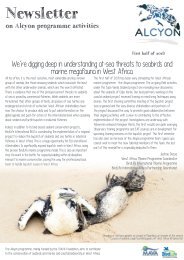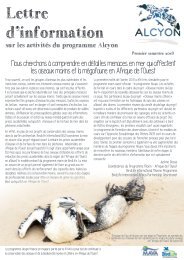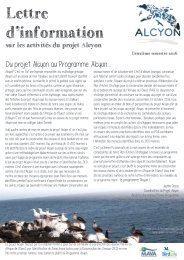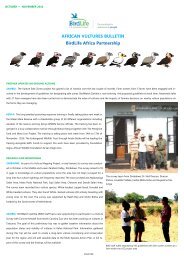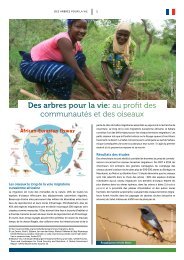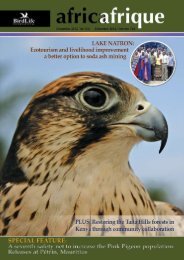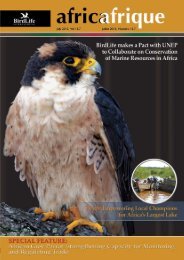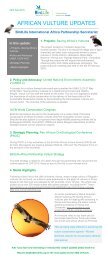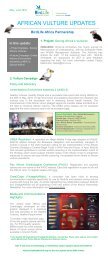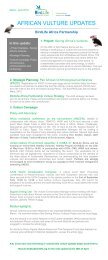VBN -Trees for Life (EN)
VBN -Trees for Life (EN)
VBN -Trees for Life (EN)
You also want an ePaper? Increase the reach of your titles
YUMPU automatically turns print PDFs into web optimized ePapers that Google loves.
TREES FOR LIFE 1<br />
Little Tern<br />
Red Knot<br />
Shorebirds<br />
Eurasian Spoonbill<br />
Bar-tailed Godwit<br />
<strong>Trees</strong> <strong>for</strong> life: how birds and people profit<br />
African-Eurasian flyway<br />
South<br />
America<br />
Ruddy Turnstone<br />
North America<br />
Western<br />
Europe<br />
West Africa<br />
Southern<br />
Africa<br />
Arctic<br />
Common Redstart<br />
Turtle Dove<br />
Barn Swallow<br />
Honey Buzzard<br />
Landbirds<br />
Red-backed Shrike<br />
Birds on the African Eurasian Flyway<br />
Migration is one of the natural wonders on our planet, with 20% of all<br />
known bird species making regular seasonal movements. Many travel<br />
thousands of miles between their breeding places and their wintering<br />
grounds. But globally, more than 40% of migratory species are declining<br />
and nearly 200 are classified as threatened. 1 They face habitat loss and<br />
other threats in their breeding and wintering grounds, but on top of that<br />
their long journeys can be perilous: they battle bad weather, illegal<br />
hunting, collisions with infrastructure and the loss of critical stop-over<br />
sites to rest and feed. Along the African Eurasian Flyway, the Sahara is<br />
one of the major challenges <strong>for</strong> migratory landbirds. Tiny birds like the<br />
1 http://www.birdlife.org/worldwide/programmes/migratory-birds<br />
2 Leo Zwarts, Rob G. Bijlsma, Jan van der Kamp, Marten Sikkema & Eddy Wymenga<br />
(2015) Moreau’s paradox reversed, or why insectivorous birds reach high densities<br />
in savanna trees, Ardea 103<br />
Africa<br />
Asia<br />
chiffchaff or common redstart cross it twice a year. The Sahel, the semiarid<br />
ecozone just South of the Sahara is a crucial area <strong>for</strong> their survival,<br />
because it’s the first place where they can rest and feed.<br />
Research outcomes<br />
Researchers undertook to start filling the huge knowledge gaps on<br />
migratory landbirds in West Africa. From 2007 to 2015, they conducted<br />
a survey of unprecedented size where they counted birds in over 300<br />
000 trees in Senegal, Mauritania, Mali and Burkina Faso. 2 Birds were<br />
found to be highly selective in their tree choice: no migratory birds were<br />
found in 69% of the tree species. Bird densities were higher in thorny<br />
trees, in trees with berries (such as Salvadora persica) and near flood-<br />
Common Redstart<br />
© Michiel van den Bergh © Daniele Occhatio/AGAMI
TREES FOR LIFE 2<br />
plains and other wetlands. Most migratory landbirds were – maybe<br />
counterintuitively - found in the driest parts of the Sahel in the savanna<br />
(woodland and shrubland) landscapes up to the 800 mm rain belt.<br />
The researchers discovered that important tree species <strong>for</strong><br />
the survival of migratory landbirds are: Salvadora persica,<br />
Acacia kirkii, Faidherbia albida, Acacia nilotica, Acacia tortilis<br />
and Balanites aegyptiaca. Also important are Acacia senegal,<br />
Euphorbia balsamifera, Acacia seyal and Ziziphus mauritiana.<br />
In the wetter zones with more than 800 mm rain the few birds<br />
present were almost only found in Faidherbia albida and<br />
Acacia nilotica.<br />
Tree research<br />
© Eddy Wymenga<br />
Bird-friendly tree species also benefit people<br />
People benefit greatly from increased tree cover and diversity near<br />
their homes and fields 3: <strong>for</strong> food and nutrition, improving soil and<br />
hydrology. Looking at the list of bird-friendly tree species, many of<br />
those have specific benefits <strong>for</strong> people. For example, Faidherbia is<br />
widely favoured by farmers <strong>for</strong> its soil improvement properties and<br />
ability to provide shade and fodder. Balanites nuts make a good oil,<br />
that generates extra income. Acacia species deliver gum Arabic, a very<br />
valuable resin. Salvadora fruits are eaten and the twigs have been used<br />
<strong>for</strong> centuries as toothbrush. Healthy bird biodiversity can furthermore<br />
provide positive benefits including pest control, and bird populations<br />
can act as a sentinel of sustainable land use.<br />
What can we do: hands-on?<br />
Many governments, developmental partners, nature conservation<br />
organisations and farmers work on landscape restoration, tree planting<br />
and other re-greening ef<strong>for</strong>ts in the Sahel region. If these actors<br />
would prioritise the planting and regeneration of bird-friendly tree<br />
species this would upgrade the biodiversity and livelihood outcomes<br />
of their work. A good choice of tree species is there<strong>for</strong>e a simple<br />
measure, with great potential impacts!<br />
Choosing the right bird-friendly trees <strong>for</strong> our re-greening ef<strong>for</strong>ts<br />
should always be based on local people’s preferences and local growth<br />
conditions.<br />
The challenge in the protection of populations of migratory landbirds<br />
is that they do not flock together in defined nature areas, they are<br />
widespread in the landscape. There<strong>for</strong>e we need many actors to join<br />
the flock and start using the bird-friendly trees throughout Sahelian<br />
landscapes.<br />
What can we do: policy frameworks?<br />
Migratory bird species are protected under the Convention on Migratory<br />
Species (CMS), which adopted an action plan <strong>for</strong> landbirds in the<br />
African Eurasian Flyway in 2014. 4 To deliver this action plan, we need<br />
other policy initiatives and institutes to join in and to take biodiversity<br />
into account when working on responsible land use in West Africa.<br />
Initiatives such as the Bonn Challenge, Forest and Landscape Restoration<br />
Mechanism and the Great Green Wall, policy instruments such as<br />
the Rio Conventions (on climate (UNFCCC), biodiversity (CBD) and<br />
land degradation (UNCCD)) and international institutions are there<strong>for</strong>e<br />
crucial actors <strong>for</strong> the protection of migratory landbirds.<br />
Contact<br />
We invite you to contact us to find out more about the work<br />
of the Bird<strong>Life</strong> Partnership in this sphere, and move <strong>for</strong>wards<br />
together <strong>for</strong> people and birds in West Africa.<br />
Danielle van Oijen, <strong>VBN</strong> - Bird<strong>Life</strong> Netherlands<br />
danielle.vanoijen@vogelbescherming.nl<br />
M.G. Boyi, NCF - Bird<strong>Life</strong> Nigeria<br />
boyi.garba@ncfnigeria.org<br />
Funded by<br />
Faidherbia albida<br />
© Danielle van Oijen<br />
3 Bhaskar Vira, Christoph Wildburger & Stephanie Mansourian (eds.) (2015) Forests,<br />
<strong>Trees</strong> and Landscapes <strong>for</strong> Food Security and Nutrition. A Global Assessment<br />
Report. IUFRO World Series Volume 33.<br />
4 http://www.cms.int/sites/default/files/document/cop11_Doc_23_1_4_Rev1_<br />
Landbirds_AP_E.pdf<br />
October 2016



